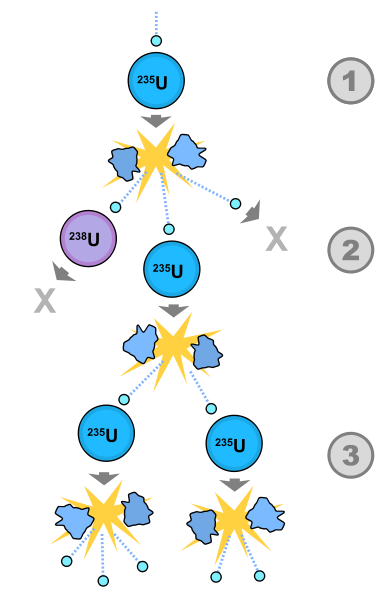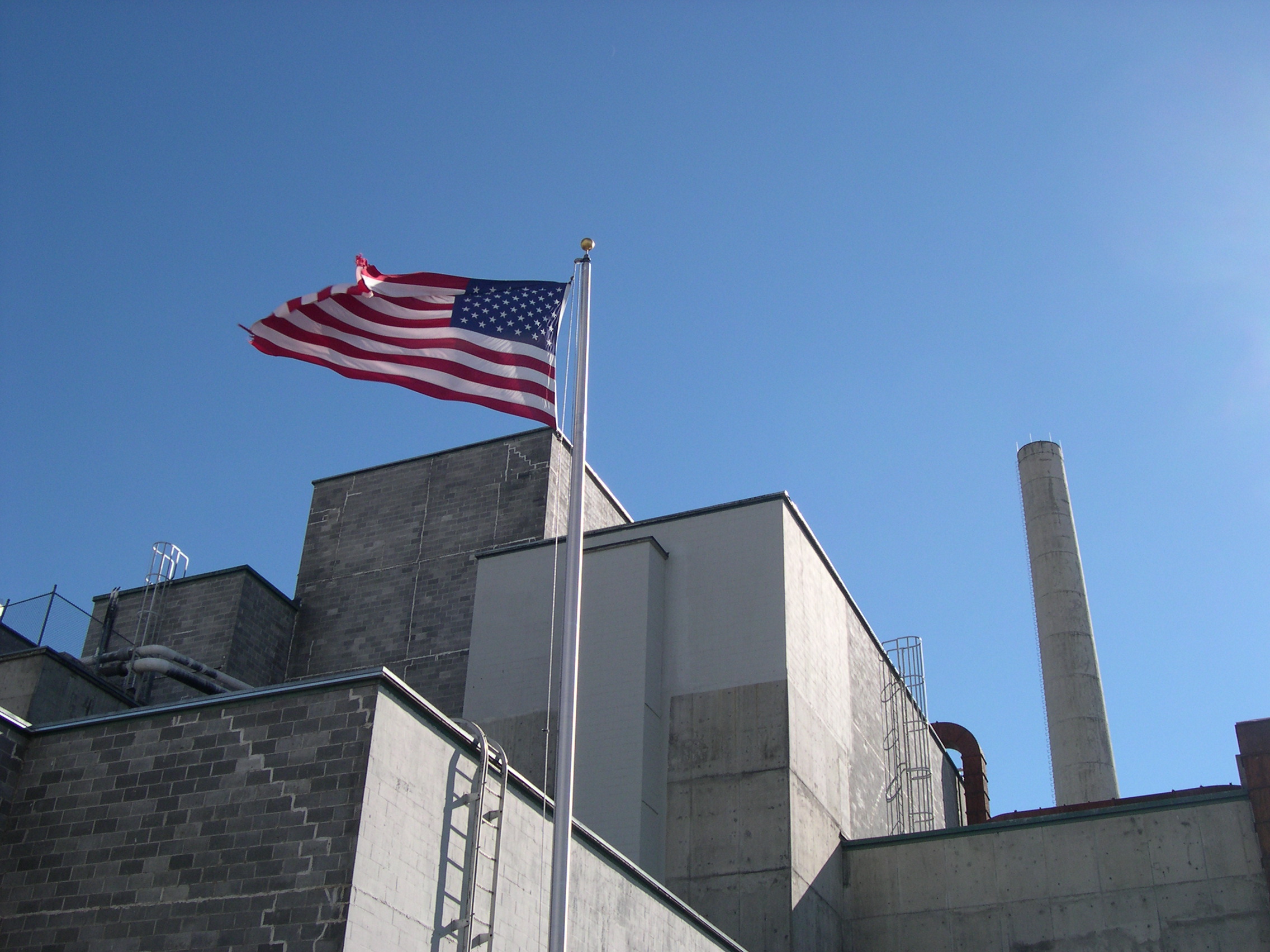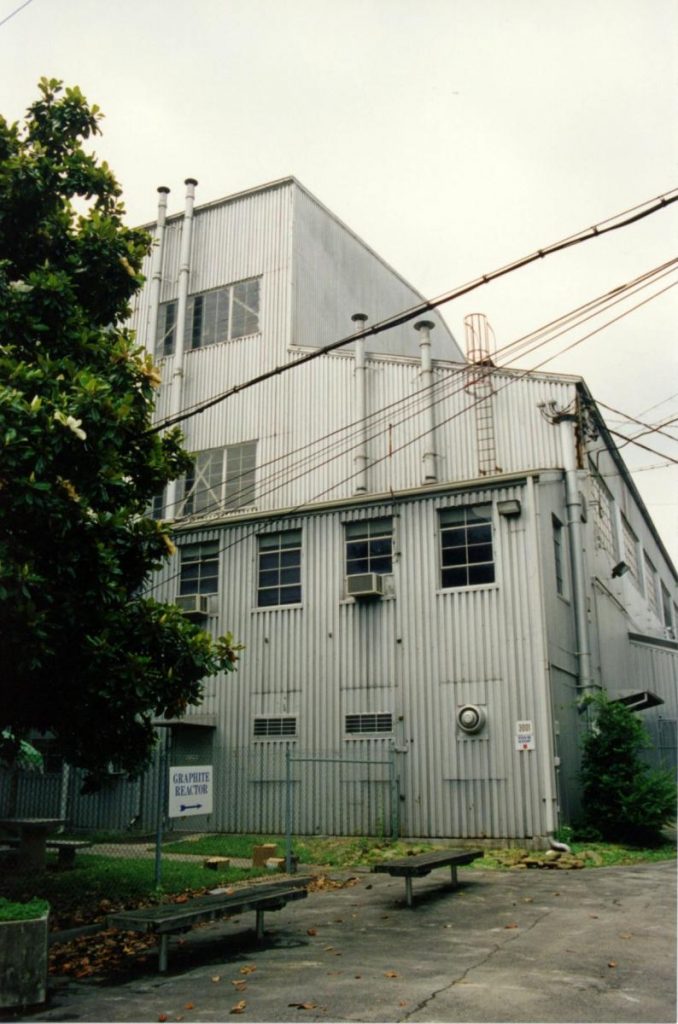A nuclear reactor is a device that initiates, moderates, and controls the output of a nuclear chain reaction. They usually consist of a number of components – a fuel source, control rods, a moderator, coolant, and an encasement. Nuclear reactors are used to produce power, for medical science, and to create materials for nuclear weapons. The first nuclear reactors were constructed during the Manhattan Project, and used to produce the uranium and plutonium that would eventually go into the Fat Man and Little Boy bombs. After the war, scientists developed nuclear reactors for civilian energy needs, and today they account for almost 20% of national power output.
How Reactors work
Nuclear reactors, at their most basic level, work by splitting atoms. A sample of a fissile material (usually uranium or plutonium) is bombarded with neutrons. This causes the already unstable nucleus to split, releasing kinetic energy, gamma radiation, and free neutrons. If there is a critical mass of material, then the neutrons which are released by the initial fission will themselves set fission in other atoms, creating a chain reaction. The continuous release of kinetic energy from the chain reaction is what provides the power produced by nuclear power plants.
Reactors are usually powered by radioactive fuel pellets, often composed of uranium oxide. In early reactors, like the Hanford B Reactor, these pellets were loaded into fuel tubes, separated by spacers, with 64,000 fuel elements being used when the reactor was fully operational. Spent fuel pellets were deposited into a water bath at the back of the reactor.
Nuclear reactors use a number of safety measures to control and effectively channel chain reactions. Control rods are long rods of neutron-absorbing elements which can be inserted into the reactor to slow or stop a reaction in progress. Early reactors used primarily boron, but other metals like silver, cadmium, and nickel are now also used. In the very first reactor, Chicago Pile 1, a SCRAM system was used, SCRAM standing for “Single Control Rod Ax Man.” In the event of an emergency, the reactor operator would use an ax to cut a rope, dropping a control rod into the reactor and poisoning the reaction. Since then, safety systems have grown more sophisticated.
A moderator is a substance used to slow and control the proceeding of the fission process. Moderators include regular (“light”) water, heavy water (where the hydrogen isotope deuterium is used in large quantities), and graphite. Most reactors also require a coolant of some sort, usually water. Coolants are used to remove excess heat from the reactor core, preventing a meltdown.
Reactors produce a number of by-products, some short-lived, and some with much longer half-lives. At the B Reactor, fuel elements were left to cool for 90 days, so that isotopes like Iodine-131 could decay. Even after less-stable elements have decayed, longer-lived elements like plutonium pose a serious challenge to safe and secure disposal of radioactive waste.
Chicago Pile 1
The first self-sustaining nuclear reactor was constructed at Arthur Compton’s Metallurgical Lab (“Met Lab”) at the University of Chicago in 1942. Chicago Pile-1 (“CP-1”) was designed by Compton’s chief engineer, Thomas V. Moore, and constructed under the west stands of University of Chicago’s defunct football stadium, Stagg Field. The pile itself was just that – a pile of uranium fuel elements and graphite blocks which would act as moderators. There was no coolant and no radiation or heat shielding. While Moore was constructing the pile, Enrico Fermi worked with a smaller model unit to understand the dynamics of pile operation.
On December 2, 1942, the pile went critical. Fermi inserted the first slug, and he was on hand to watch the world’s first artificial self-sustaining nuclear reaction, alongside Leo Szilard, Eugene Wigner, Leona Woods Marshall, DuPont’s Crawford Greenewalt, and others. The CP-1 reactor, however, was purely scientific, and did not produce any elements for war-time use.
X-10
The X-10 Graphite Reactor, constructed at Oak Ridge, was the first nuclear reactor designed for continuous operation. X-10 itself was a pilot plant, meant in part to be a proof-of-concept for larger scale nuclear reactors. The DuPont Company constructed it, breaking ground at Oak Ridge in February 1943. The reactor was designed to produce weapons-grade plutonium from natural uranium slugs, which were encased in aluminum cans from the Aluminum Company of America in order to prevent water damage or overheating. This aluminum was shipped to X-10 on June 17, 1943, and the loading of the reactor began on October 31, 1943.
In the early morning of November 4th, 1943, the pile went critical – by the end of the month, it had produced its first plutonium. It was so successful that by the very end of 1943, the X-10 reactor was providing the first plutonium samples to the University of Chicago. In February of 1944, the Los Alamos lab received its first shipment of plutonium.
The B Reactor
The B Reactor at Hanford was based on the work that Manhattan Project scientists had already done on the CP-1 and X-10 Reactors. It was also graphite-mediated, water-cooled, could hold over 60,000 elements in its 2,004 process tubes, and could produce up to 250 megawatts. It used three redundant shutdown mechanisms – 9 horizontal control rods, 29 back-up vertical control rods, and a last-resort boron mechanism, which began as a boron-based acid, but was then replaced with hundreds of small boron balls dropped into the machine with a hopper. The reactor was cooled with some 30,000 gallons of water every minute.
It went critical on midnight of September 27th but, just three hours later, suddenly began to shut down. Upon investigation, it was discovered that the nuclear chain reaction had been “poisoned” by Xenon-135, a fission product which absorbed large numbers of neutrons. Luckily, DuPont engineers had insisted on using 2,000 tubes, rather than the 1,500 that the design had originally called for. This clever redundancy meant that sufficient nuclear elements could be added to overcome the poisoning.
 Atoms for Peace
Atoms for Peace
After the war, America raced to become the first nation to develop civilian nuclear energy, envisioning a future where electricity was, “too cheap to meter.” In 1950, the Atomic Energy Commission had Argonne National Laboratory set up and take responsibility for the National Reactor Testing Station at Idaho Falls, Idaho.
EBR-1
In 1951, the Experimental Breeder Reactor (EBR-1) was constructed, the world’s first breeder reactor. A breeder reactor is a kind of reactor which converts uranium into plutonium while operating, creating more fuel than it uses up. EBR-1 was the first nuclear reactor to generate usable quantities of electricity, lighting up four light bulbs. It used the heat produced by nuclear fission to create steam, powering a turbine which drove a generator, creating electricity.
The success of EBR-1 led to the construction of EBR-2, which was 20 times the size of EBR-1, and a prototype for commercial power reactors. It was also where the process of recycling fuel was perfected – it ran for five years on recycled fuel, leaving behind only a small volume of waste material.
MTR/BORAX-1/SPERT
 Feeling the need for better experimental information on how reactors worked, the team at Idaho Falls constructed a number of reactors for explicitly experimental purposes. The Materials Test Reactor (MTR) had a much higher “neutron flux” (the number of neutrons impacts in a certain area per second) than most other reactors, allowing for accelerated testing. The MTR was used in over 12,000 experiments, including on the durability of fuel rods, the effectiveness of shielding materials, and how enriched uranium fuel would perform.
Feeling the need for better experimental information on how reactors worked, the team at Idaho Falls constructed a number of reactors for explicitly experimental purposes. The Materials Test Reactor (MTR) had a much higher “neutron flux” (the number of neutrons impacts in a certain area per second) than most other reactors, allowing for accelerated testing. The MTR was used in over 12,000 experiments, including on the durability of fuel rods, the effectiveness of shielding materials, and how enriched uranium fuel would perform.
The BORAX-1 (BOiling water ReActor eXperiment) was a test of the safety involved in placing a nuclear power reactor near a city; its successor, BORAX-3, would eventually light the entirety of the nearby town of Arco, Idaho. The SPERT (Special Power Excursion Reactor Test) was a reactor designed to “explore the limits of a reactor’s behavior” – it tested what could go wrong in a nuclear reactor, and what could be done to resolve problems.
Reactors Today
Today, the United States has 99 nuclear reactors in 30 states, operated by 80 different companies. They collectively produced 805.3 billion kilowatt hours in 2016, accounting for over 19.7% of electrical output. The United States is the world’s largest producer of nuclear energy, accounting for about 30% of total nuclear energy production. Since the time of the Manhattan Project, American use of nuclear power, and therefore nuclear reactors, has only continued to grow.







